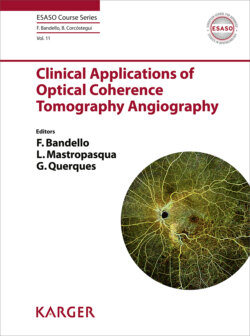Читать книгу Clinical Applications of Optical Coherence Tomography Angiography - Группа авторов - Страница 21
На сайте Литреса книга снята с продажи.
Abstract
ОглавлениеOptical coherence tomography angiography (OCTA) has revolutionized the field of ophthalmology to the benefit of all its subspecialties. In the field of ocular oncology, much of its role has been in the evaluation of choroidal melanoma and complications of radiation. Although the role of OCTA in the identification of choroidal melanoma is mainly to determine changes in parafoveal microvasculature (capillary vascular density; CVD) rather than visualization of intratumoral vascularity, it is highly valuable in the early detection and management of radiation retinopathy. Through OCTA, eyes treated with radiation for uveal melanoma show an increased foveal avascular zone (FAZ), reduction in CVD, and reduced vessel complexity, occurring at both the superficial and deep capillary plexus even in eyes without clinical or OCT-evident signs of retinopathy. Furthermore, OCTA provides new insights into the natural history of radiation retinopathy, with irradiated eyes showing a reduction in capillary density, even before symptomatic vision loss, FAZ enlargement, or macular edema. It should be realized, however, that its inability to detect leakage, scan depth, image quality, artifacts, as well as lack of normative data are current limitations of OCTA; hence, it is not a replacement but instead should be used in conjunction with traditional intravenous fluorescein angiography.
© 2020 S. Karger AG, Basel
Choroidal melanoma is a deadly malignancy and is also the most common primary intraocular tumor in adults with increasing risk per millimeter increase in thickness [1–5]. Our continued understanding of signs identifying high-risk tumors now allows early detection, when melanomas are small and life prognosis is better [6–12]. Through the years, there has also been constant evolution in ocular imaging in parallel with improved treatment outcomes, globe salvage, and visual outcomes. These ancillary tests help clinicians identify melanomas earlier and manage treatment complications, ranging from ultrasonography, intravenous fluorescein angiography (IVFA), indocyanine green angiography (ICGA), to optical coherence tomography (OCT) [12–27]. Today, this process of evolution has taken us to non-invasive, dyeless, high-resolution angiography using OCT technology in the form of OCT angiography (OCTA) [28, 29].
Here, we review the use of OCTA in the evaluation of choroidal melanoma, particularly its role in differentiating melanomas and pseudomelanomas, in addition to discussing its utility in the early detection and management of radiation retinopathy. Lastly, we deliberate the current limitations of OCTA technology and future developments that could be relevant in ocular oncology.
